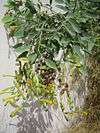Nicotiana glauca
| Nicotiana glauca | |
|---|---|
| | |
| Scientific classification | |
| Kingdom: | Plantae |
| (unranked): | Angiosperms |
| (unranked): | Eudicots |
| (unranked): | Asterids |
| Order: | Solanales |
| Family: | Solanaceae |
| Genus: | Nicotiana |
| Species: | N. glauca |
| Binomial name | |
| Nicotiana glauca Graham | |
Nicotiana glauca is a species of wild tobacco known by the common name tree tobacco. Its leaves are attached to the stalk by petioles (many other Nicotiana species have sessile leaves), and its leaves and stems are neither pubescent nor sticky like Nicotiana tabacum. It resembles Cestrum parqui but differs in the form of leaves and fusion of the outer floral parts. It grows to heights of more than two meters.
Tree tobacco is native to South America but it is now widespread as an introduced species on other continents. It is a common roadside weed in the southwestern United States, and an invasive plant species in California native plant habitats.
The plant is used for a variety of medicinal purposes and smoked by Native American groups.[1] The Cahuilla Indians used leaves interchangeably with other tobacco species in hunting rituals and as a poultice to treat swellings, bruises, cuts, wounds, boils, sores, inflamed throat, and swollen glands. Contains the toxic alkaloid anabasine. Ingestion of the leaves can be fatal.[2] It is being investigated for use as a biofuel.[3]
Gallery
| Wikimedia Commons has media related to Nicotiana glauca. |
References
- ↑ Ethnobotany
- ↑ Foster, Steven (2002). Western Medicinal Plants and Herbs. Boston, NY: Houghton Mifflin Company. p. 339. ISBN 0-395-83806-1.
- ↑ Prickly Pears and Tree Tobacco for Ethanol Production in Semi-Arid Regions
External links
- Jepson Manual Treatment
- USDA Plants Profile
- GRIN Species Profile
- Nicotiana%20glauca http://www.pfaf.org/user/Plant.aspx?LatinName=Nicotiana+glauca Plants For A Future: Nicotiana glauca
- Photo gallery


